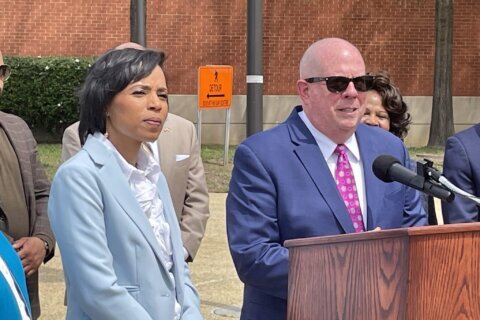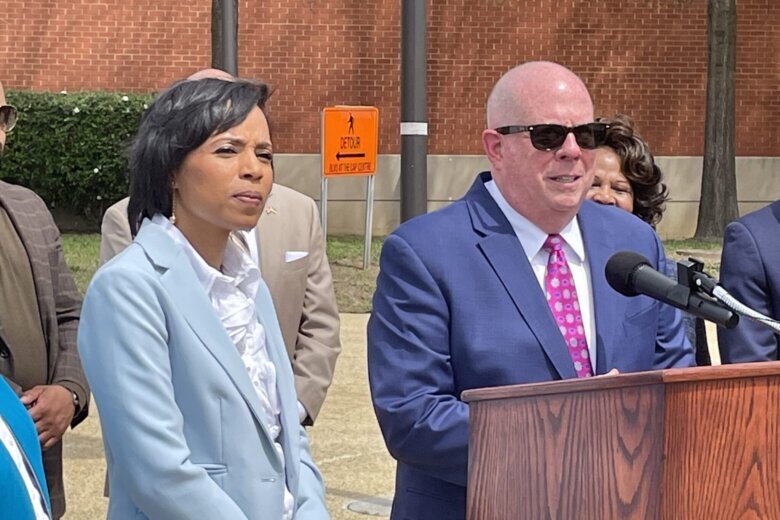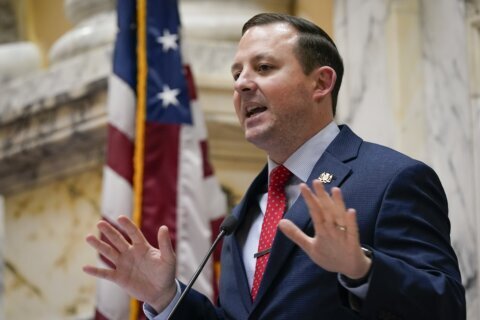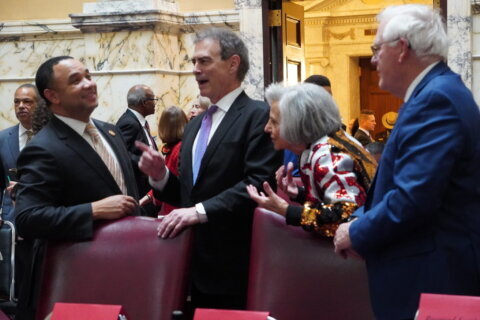This article was republished with permission from WTOP’s news partners at Maryland Matters. Sign up for Maryland Matters’ free email subscription today.

The Maryland Senate race between former Gov. Larry Hogan (R) and Prince George’s County Executive Angela Alsobrooks (D) is in a dead heat, according to a new poll commissioned by AARP, the advocacy group for seniors.
The same poll showed a commanding lead for Vice President Kamala Harris over former President Donald Trump in Maryland — indicating that Hogan so far is succeeding in convincing many voters to split their ballots between the political parties.
But the survey also suggests Hogan may be falling just short of the Democratic support he needs to guarantee victory — and that Alsobrooks, who is less well known to voters at the moment, has more room to grow over the final two months of the campaign.
The Senate race “literally couldn’t be closer,” said Bob Ward, one of two pollsters who designed and conducted the survey, on a Zoom call Monday with Maryland Matters.
Ward, with the Republican polling firm Fabrizio Ward, and Jeff Liszt, of the Democratic firm Impact Research, are conducting surveys for AARP across 10 states with competitive elections.
In the Maryland Senate race, Alsobrooks and Hogan each polled at 46%, with 7% of those surveyed undecided and 1% preferring other candidates. The poll of 600 likely voters was taken Aug. 14-20 and had a 4-point margin of error.
Hogan had a robust 55%-32% advantage over Alsobrooks among independent voters, while her lead among Democrats was 68%-26%.
“That’s what’s obviously keeping him in the race,” Ward said.
Both candidates were viewed quite favorably by voters, but Hogan was better known, another part of the political dynamic in the state.
“We haven’t seen a survey like this this year,” Liszt said. “The story there comes down to name ID.”
Hogan was viewed favorably by 59% of voters, compared to 28% who viewed him unfavorably. Alsobrooks was viewed favorably by 41% of voters and unfavorably by 16%. That’s a huge gap in name recognition, meaning she’s going to need to spend more time and resources working to make herself known to voters across the state
The pollsters also oversampled senior voters and Black voters in Maryland, two critical voting blocs. Eighty-seven percent of voters in Maryland over the age of 50 said their motivation to vote is a 10-out-of-10, compared with only 70% of voters 18-49 who have the same level of enthusiasm. In the 2022 midterm elections, 50+ voters made up 62% of the Maryland electorate.
“What we’ve learned is that candidates in Maryland ought to be paying attention to the concerns of older voters,” said Hank Greenberg, AARP’s Maryland director.
The Senate race is very close among voters older than 50, with Hogan ahead 47%-45%, within the poll’s margin of error. In that broad demographic, he topped Alsobrooks 52%-39% among voters 50-64, while she led 51%-43% among voters 65 and older.
The pollsters said that voters in the 50-64 demographic are generally leaning toward Republicans across the country, while those 65 and older, aging Baby Boomers, remain more liberal.
Black voters represent about 30% of the electorate in Maryland, and while their support for Harris is resolute in the White House election, their disposition could prove critical in the Senate race, where Alsobrooks is trying to make history by becoming the third Black woman elected to the U.S. Senate — and the first from Maryland.
Alsobrooks is ahead by a whopping 52 points among Black voters who are 50+. But the race is much closer among Black voters 18-49, where Alsobrooks is up by 18 points. In his successful races for governor in 2014 and 2018, Hogan took about 30% of the Democratic vote, and he also took about 30% of the Black vote in 2018, even though his Democratic challenger, Ben Jealous, was Black.
The AARP pollsters said Alsobrooks’ lower level of support among younger Black voters is largely a function of her lower name recognition in that demographic compared to older Black voters. Overall, among voters of all races ages 18-34, Hogan is leading Alsobrooks 50%-40% — which is also due to her considerably lower name ID with voters in that bracket.
Hogan’s ability to remain competitive against Alsobrooks, in a fundamentally blue state, may depend on his capacity to keep his numbers in the 30% range with Black voters and Democrats.
“The state has the highest percentage of ticket splitters, especially for voters over 50, that we’ve seen,” said Liszt. “But the fundamentals and the presidential ballot suggest you would put your money on the Democrat prevailing.”
Presidential race: Harris in command
In the White House election, Harris will have no problem winning the state by a huge margin, the survey showed.
In a head-to-head matchup with Trump, she led 64% to 32%, with 3% undecided and 1% expressing a preference for someone else. In a test of all presidential candidates, Harris took 59% compared to 29% for Trump. Robert F. Kennedy Jr. — who suspended his campaign and endorsed Trump last week, though he will remain on the Maryland ballot — was at 5% in the poll. Green Party candidate Jill Stein and Libertarian Party candidate Chase Oliver each took 1%.
That’s consistent with the results of the 2020 presidential election, when President Biden won 65% of the vote in Maryland compared with Trump’s 32%.
Harris led with every demographic in Maryland, except for Republicans, where Trump unsurprisingly had an 83%-14% advantage.
In the poll, Harris was viewed favorably by 61% of voters, while 33% viewed her unfavorably. Trump’s numbers were underwater, with 30% viewing him favorably and 65% unfavorably. Biden’s favorable to unfavorable rating was 51%-42%. Gov. Wes Moore (D) was viewed favorably by 57% of voters and unfavorably by 21%.
Seniors’ priorities
In the survey, 52% of older voters in Maryland said Social Security is or will be a major source of their income, and 79% said candidate positions on Social Security are “extremely or very important” in determining their vote in November — which was the highest priority out of any issue polled.
Sixteen percent of older voters identified themselves as swing voters who aren’t going to be straight-ticket voters at either the presidential or Senate level. Among swing voters, economic issues led the way, with personal economic issues like inflation, Social Security, jobs and taxes being the top issues they care about.
Swing voters were more likely to be family caregivers: one-third of swing voters 50+ identified themselves as family caregivers. To this demographic, issues like Social Security and Medicare price negotiation stand out as disproportionately important.
“The economy is really the backdrop to this election,” Wade said. He added, that many races this year are impossible to predict: “Anything could happen. It’s 2024.”








